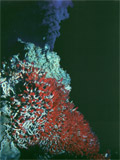investigations
background
Biology
Biology of Vent Communities
Teeming with Life
Before the discovery of hydrothermal vent fields, the deep-ocean floor was largely thought of as a dark, cold, and lifeless region of rock, mud, and sand, covered by layers of debris slowly settling out from the overlying ocean. Now we know that, for example, the hydrothermal vent fields of the northeast Pacific are home to shimmering black smokers that teem with life, including colonies of swaying lipstick-like tube worms, pink and white long-legged crabs, mounds of limpets, mussels, and clams.
Biological Communities
For most of us the word 'community' is associated with our neighborhood, the schools, the churches, the library, and all the other services developed by humans living in groups. We tend to think of a community as people-centric, but biologists think about community in terms of all life forms and their habitats. A biological community includes all the organisms in an ecosystem, and takes into consideration how each has adapted to meet survival needs. Also of great importance are the interrelationships between the various species living in a community.
Photosynthesis
Most biological communities on land depend on sunlight to provide energy for food production. Food provides the cellular energy needs of an organism to carry on the business of life. A simple food chain might go as follows: Plants (autotrophs) make their own food using photosynthesis; other animals eat plants (herbivores), who in turn are eaten by predators (carnivores and omnivores).
Chemosynthesis
Two miles under the sea, there is no sunlight. The autotrophs (bacteria and an even more primitive form of life called archaea) make their own food using a process called chemosynthesis. They harness the chemical energy stored in the bonds of the sulfide minerals of the vents. Some of the larger sulfide community members also use chemosynthesis, while still others play the familiar role of carnivore. These food relationships are one of the most intriguing characteristics of hydrothermal vent communities.
Tubeworms
The stars of the vent macrofauna (non-microscopic animals) are the tubeworms (Ridgeia piscesae). They often dominate the biotic landscape with their spaghetti-like tubes made of chitin, like your finger nails. These tubes have flared collars every few centimeters like bamboo. The worm lives inside the tube, whichis attached at one end to the lithic (rocky) vent structure. They are literally gutless wonders having no mouth, no gut, and no anus, yet inside one finds a body cavity (a trophosome) filled with a vast quantity of symbiotic sulfur-oxidizing bacteria. The bacteria are sheltered and fed by the tubeworm, and the tubeworm, in turn, makes its food from what the bacteria produce chemosynthetically. When not retracted for protection, tubeworms display beautiful red plume-like gills filled with hemoglobin in order to extract and transfer a variety of gases (mainly oxygen) from the seawater. Squint a little at a "bush" of tubeworms, and your scene could be from some Hollywood show-stopper where the camera has just focused in from above on a hundred dancers topped with extravagant red-feathered hats dancing in the local cross currents at 1.5 miles depth.
